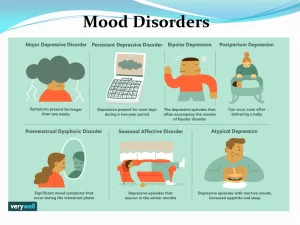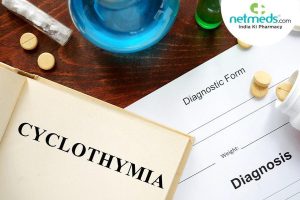Introduction Mood disorders constitute a vast category within the realm of mental health, encompassing a spectrum of conditions that affect an individual’s emotional well-being. Among the most prevalent are major depression and bipolar disorder, each presenting unique challenges and nuances. This comprehensive exploration aims to shed light on the intricacies of mood disorders, from their
Introduction
Mood disorders constitute a vast category within the realm of mental health, encompassing a spectrum of conditions that affect an individual’s emotional well-being. Among the most prevalent are major depression and bipolar disorder, each presenting unique challenges and nuances. This comprehensive exploration aims to shed light on the intricacies of mood disorders, from their diverse types to underlying causes, recognizable symptoms, diagnostic approaches, and effective treatment modalities.

Image by:: www.pexels.com
Types of Mood Disorders
- Major Depression:
- Key Characteristics: Individuals experiencing major depression often grapple with persistent sadness, a profound loss of interest in activities they once enjoyed, and an array of associated symptoms that endure for a minimum of two weeks.
- Impact: This condition significantly hampers daily functioning, affecting everything from work to personal relationships.
- Dysthymia:
- Chronic Low-Grade Mood: Dysthymia manifests as a prolonged, low-grade depressive or irritable mood, persisting for a minimum of two years.
- Subtle, Yet Enduring: While the symptoms may be less intense than major depression, the prolonged duration can have a substantial impact on an individual’s overall quality of life.
- Bipolar Disorder:
- Cyclical Mood Swings: Bipolar disorder is characterized by distinct periods of depression alternating with episodes of mania or elevated mood.
- Challenge of Variability: The oscillation between extremes presents a unique challenge in diagnosis and management.
- Mood Disorder Related to Another Health Condition:
- Triggered by Medical Illnesses: Various medical conditions, including cancer, injuries, infections, and chronic illnesses, can induce symptoms of depression.
- Intersection of Physical and Mental Health: The interplay between physical health and mental well-being underscores the complexity of mood disorders.
- Substance-Induced Mood Disorder:
- Symptoms Due to External Factors: Depression symptoms may arise as a result of the effects of medication, drug abuse, alcoholism, exposure to toxins, or other forms of treatment.
- Interconnected Challenges: Substance-induced mood disorders highlight the intricate relationship between external factors and mental health.

Image by: yendex.com
Causes and Risk Factors
Understanding the origins of mood disorders involves navigating a multifaceted landscape of biological, genetic, and environmental factors. While the precise cause remains elusive, there is a consensus among healthcare providers that imbalances in brain chemicals contribute significantly. Additionally, a genetic predisposition is evident, with mood disorders often running in families.
- Genetic Predisposition:
- Family Connections: Individuals with a family history of mood disorders, be it depression or bipolar disorder, face an elevated risk of developing similar conditions.
- Link to Bipolar Disorder: Relatives of individuals with depression also show an increased susceptibility to bipolar disorder.
- Environmental Factors:
- Life Events and Stress: Stressful life changes, such as job loss, divorce, bereavement, and financial difficulties, can act as triggers for mood disorders.
- Amplifying Emotional Struggles: Life events can exacerbate existing feelings of sadness or depression, making the emotional burden more challenging to manage.
- Gender Disparities:
- Higher Risk in Women: The prevalence of depression is nearly twice as high in women compared to men.
- Cross-Generational Impact: Once a person in the family receives a diagnosis of a mood disorder, their siblings, children, and even relatives face an increased likelihood of a similar diagnosis.

Image by: yendex.com
Symptoms of Mood Disorders
The symptoms of mood disorders manifest in a myriad of ways, varying with age and the specific type of disorder. Recognizing these signs is crucial for early intervention and effective management.
- Emotional Symptoms:
- Ongoing Sadness: A pervasive and enduring sense of sadness, often described as feeling “empty” or anxious.
- Hopelessness: A profound feeling of despair and helplessness.
- Low Self-Esteem: Individuals may harbor feelings of inadequacy or worthlessness.
- Excessive Guilt: An overwhelming sense of guilt, even in situations where it is unwarranted.
- Cognitive Symptoms:
- Suicidal Thoughts: Thoughts of death or suicide, and in severe cases, attempts at self-harm.
- Loss of Interest: Diminished interest in activities that were once pleasurable, including relationships and hobbies.
- Concentration Difficulties: Impaired ability to focus or make decisions, impacting daily functioning.
- Physical Symptoms:
- Sleep Disturbances: Trouble sleeping or, conversely, excessive sleeping.
- Appetite Changes: Fluctuations in appetite leading to weight loss or gain.
- Fatigue: Persistent lack of energy, contributing to a sense of lethargy.
- Behavioral Symptoms:
- Relationship Struggles: Difficulties in interpersonal relationships, often stemming from irritability or aggression.
- Escapist Behaviors: Running away from home or expressing the desire to do so.
- Sensitivity to Rejection: Heightened sensitivity to failure or rejection.
These symptoms, when present, significantly exceed normal fluctuations in mood and persist over time, impacting an individual’s engagement with family, friends, work, and community.

Image by: yendex.com
Diagnosing Mood Disorders
Accurate diagnosis is pivotal in devising effective treatment plans for mood disorders. Psychiatrists and mental health professionals typically employ a thorough medical history and psychiatric evaluation to understand the nuances of an individual’s condition.

Image by: yendex.com
Treatment Approaches
While mood disorders can pose significant challenges, effective treatments exist to empower individuals on their journey to recovery. Treatment modalities may include a combination of:
- Medications:
- Antidepressants: Targeting the imbalance of brain chemicals associated with depression.
- Mood Stabilizers: Managing the oscillations between depressive and manic episodes in bipolar disorder.
- Psychotherapy:
- Cognitive-Behavioral Therapy (CBT): Focused on challenging and changing distorted thought patterns.
- Interpersonal Therapy: Enhancing interpersonal relationship skills and identifying environmental stressors.
- Family Therapy:
- Involvement of Support Systems: Engaging family members in the therapeutic process for holistic support.
- Other Therapies:
- Electroconvulsive Therapy (ECT): Employed in severe cases where other treatments prove ineffective.
- Transcranial Stimulation: A non-invasive technique influencing brain activity to alleviate symptoms.

Image by: www.health.com
Empowering Families in the Treatment Journey
Families play an indispensable role in the support and recovery of individuals with mood disorders. Understanding the challenges, participating in therapy sessions, and offering emotional support contribute significantly to the overall effectiveness of the Explore more treatment process.
Prevention and Key Takeaways: Navigating the Path Forward
While specific prevention strategies for mood disorders remain elusive, early diagnosis and intervention significantly mitigate the severity of symptoms. Timely treatment not only alleviates immediate challenges but also fosters normal growth and development, enhancing the overall quality of life for those affected.
Types of Mood Disorders
| Mood Disorder | Key Characteristics |
|---|---|
| Major Depression | Persistent sadness, loss of interest for at least 2 weeks. |
| Dysthymia | Chronic, low-grade mood lasting a minimum of 2 years. |
| Bipolar Disorder | Alternating periods of depression and elevated mood. |
| Related to Health | Triggered by medical illnesses or chronic conditions. |
| Substance-Induced | Depression symptoms caused by medication or substance use. |
Conclusion
In conclusion, navigating the landscape of mood disorders requires a nuanced understanding of their diverse manifestations and contributing factors. With the right diagnosis and tailored treatment, individuals grappling with mood disorders can lead stable, productive, and fulfilling lives. By unraveling the complexities and fostering a supportive environment, society can contribute to the well-being of those navigating the challenges of mood disorders.
















